B2B eCommerce in 2025: Trends, Challenges, and Opportunities
Do you remember the days when buying and selling between businesses used to mean trade shows, printed catalogues, and a lot of back-and-forth with sales reps?
Fast forward to 2025, and most of that has moved online!
Companies are building digital storefronts, distributors are automating reorders, and even the most traditional industries are finding new ways to win customers through eCommerce.
The shift is massive. Global B2B eCommerce sales are on track to reach $3.6 trillion in 2026, with 80% of B2B interactions now happening online. Businesses that once treated digital channels as an afterthought are now rethinking their entire sales strategy to meet these expectations.
If you lead a company that sells to other businesses, this change brings both opportunity and pressure. The market is growing quickly, but competition is fierce, and buyers are far less patient than they used to be.
So, with that being said, in this guide, we’ll explore the trends driving this B2B business growth, how the leading platforms stack up, and which strategies are helping companies stand out. You’ll also see where the challenges lie, so you can plan ahead and avoid the most common pitfalls.
What is B2B eCommerce?
B2B eCommerce is the online sale of goods or services from one business to another.
While that might sound simple, the way it works is often far more complex than typical consumer shopping.
A single transaction can involve bulk orders, negotiated contracts, and multiple people on the buyer’s side approving the deal.
Here’s what it looks like in practice:
- A manufacturer giving retailers a private online portal where they can see live stock levels, place orders in bulk, and get account-specific pricing.
- A wholesale distributor automating the entire reorder process so supplies never run out for their business customers.
- A software company letting enterprise clients choose subscription tiers, add multiple users, and manage everything from billing to onboarding online.
- Large procurement marketplaces, like Alibaba or Amazon Business, connecting thousands of suppliers with businesses that want to compare and buy without leaving one site.
The technology has advanced so much that these platforms don’t just replace old ways of working; they improve on them.
Companies can offer customised pricing, faster delivery options, and self-service tools that make their clients’ lives easier, all while reducing manual admin behind the scenes.
For leaders, this is about creating a customer experience that keeps buyers coming back, helps sales teams focus on higher-value relationships, and positions the business for scalable growth over the next decade.
Why B2B eCommerce is Booming in 2025
There are plenty of reasons why B2B eCommerce isn’t slowing down, but three in particular are driving its explosive growth this year: buyer expectations, technology, and cost efficiency.
1. Buyers expect a consumer-level experience.
The decision-makers placing orders today are used to the speed and simplicity of Amazon in their personal lives. They expect the same from business suppliers.
According to Sana Commerce, 73% of B2B buyers prefer to buy online rather than through a sales rep, and they’re quick to switch providers if the process feels slow or outdated.
Features like real-time stock visibility, one-click reordering, and personalised pricing are the baseline.
2. Technology is closing the gap between online and offline.
Modern B2B platforms do far more than just list products. They integrate with ERP and CRM systems, support complex pricing rules, automate invoicing, and even use AI to recommend products based on past orders.
These tools allow businesses to scale without adding more staff, while also giving sales teams more insight into customer behaviour so they can focus on high-value relationships.
3. Digital channels are more efficient and scalable.
Running a sales team with endless calls, meetings, and quotes is expensive. Digital commerce cuts many of those costs while opening new revenue streams. Self-service portals allow buyers to handle repeat orders on their own, freeing up account managers to work on strategic deals.
Plus, online sales channels make it easier to expand into new markets without building a physical presence.
For businesses that act quickly, the next few years represent a rare chance to grab market share while many competitors are still playing catch-up.
B2B eCommerce vs B2C eCommerce
At a glance, B2B and B2C eCommerce might look similar. There’s a product, a website, a buyer, and a transaction. But once you scratch the surface, the differences are huge, especially when you’re the one managing the platform or setting the strategy.
If you’ve worked on both sides, you already know this. Selling to businesses is a very different beast compared to selling to consumers. The audience is different, the buying journey is longer, the stakes are often higher, and the tools you need behind the scenes? Far more complex!
Here’s a simple breakdown to show how the two models compare.
| Area | B2C eCommerce | B2B eCommerce |
| Audience | Individual consumers | Businesses, teams, or procurement departments |
| Order volume | Typically single or low-volume orders | Bulk purchasing, recurring orders, or long-term supply contracts |
| Pricing | Fixed pricing visible to everyone | Tiered or negotiated pricing, often unique to each account |
| Checkout experience | Fast, minimal steps, often guest checkout | Account-based, multi-step, often with approvals or purchase orders |
| Sales cycle | Quick decisions, often impulsive | Longer buying cycles, multiple stakeholders involved |
| Customer relationship | Short-term, focused on one-time or repeat consumer sales | Long-term partnerships, dedicated account managers, ongoing support |
| Platform needs | Focus on design, ease of use, conversion rate optimisation | Needs to handle complex workflows, integrations with ERP/CRM, account control |
What this table doesn’t show, though, is the mindset difference. A B2C buyer might spend five minutes browsing trainers and make a decision on the spot. A B2B buyer could be researching suppliers for weeks, comparing specs, presenting options to a procurement team, and negotiating terms before they even reach the checkout page.
Because of this, B2B websites have to feel intuitive while still offering deep functionality. Buyers want things to work fast, but they also expect the detail to be there when they need it. We’re talking spec sheets, delivery timelines, credit terms, the lot.
And if your platform can’t handle that? They’ll move on to one that can.
The good news is, B2B brands don’t need to mimic B2C to succeed. You don’t need flash sales or influencer campaigns. But what you do need is to understand that your buyers still expect speed, personalisation, and transparency. Just like consumers, they’re busy, informed, and less loyal than ever if something gets in their way.
The trick is finding the right balance between self-service and sales support, between automation and personalisation, and between efficiency and trust. That’s where the best B2B platforms, and the best B2B brands, are winning in 2025.
Types of B2B eCommerce
Not all B2B businesses sell the same way. Some are pure wholesalers. Others are manufacturers with bespoke pricing models. Some work through distributors, while others go straight to the end client. The way you structure your eCommerce offering depends a lot on your role in the supply chain and who’s actually clicking “buy.”
So, let’s walk through the main B2B eCommerce models you’ll see in 2025. You might recognise your business in one of these, or maybe it’s a mix.
1. B2B (Business to Business)
This is the classic model; a business selling directly to another business. Think industrial suppliers, packaging manufacturers, or IT hardware companies offering portals for companies to manage bulk orders, track deliveries, and access contract pricing.
If your business model relies on recurring clients, large order volumes, or negotiated terms, you’re probably in this category.
2. B2B2B (Business to Business to Business)
This one adds another layer. You’re selling to a business who then sells to another business. For example, a packaging manufacturer sells to a distributor, who then sells to retailers.
In this model, transparency and integration become really important. Everyone in the chain needs up-to-date product data, stock levels, and pricing, and the end buyer still expects a smooth experience.
3. B2B2C (Business to Business to Consumer)
This is where things get interesting. In B2B2C, you’re still selling to a business, but that business is passing your product on to a consumer, and your brand might still be visible at the end.
Let’s say you’re a coffee roaster selling to independent cafés. They sell to consumers, but your name might be on the cup. Or a skincare lab that formulates products for online retailers; you’re not selling directly to the end customer, but your product is what they’re buying.
If this is your space, branding, product presentation, and end-user experience matter more than most B2Bs think.
4. Wholesale
Wholesale is all about volume. You’re selling large quantities at lower prices to retail businesses, often through dedicated pricing tiers, minimum order quantities, and negotiated shipping terms.
Great wholesale platforms now offer private logins, instant stock checks, flexible fulfilment options, and the ability to manage dozens of SKUs in a single order. If your wholesale experience feels slow or clunky, your buyers will notice, and they’ll go elsewhere.
5. Manufacturer Direct
More and more manufacturers are cutting out the middle layers and selling directly online. This used to be unthinkable in some industries, but in 2025, it’s become the norm, especially when buyers expect faster delivery and clearer pricing.
If you’re a manufacturer building a direct-to-business channel, your platform needs to do some heavy lifting: product customisation, quote management, technical documentation, and often integration with back-end production systems. But get it right, and you control the customer relationship far more closely.
So, which model fits your business best? Or are you navigating more than one at the same time? Understanding your structure is key because it shapes everything from how your eCommerce site should work, to how you price, promote, and support your customers. And in a market this competitive, clarity gives you a real edge.
Best B2B eCommerce Platforms in 2025
There’s no shortage of eCommerce platforms claiming to be “B2B ready,” but only a handful are truly built to handle the complexity, scale, and expectations of modern business buyers. Whether you’re just getting started or planning a replat form, it helps to understand how each option fits different types of businesses.
Below are five leading B2B eCommerce platforms in 2025, each suited to different goals, budgets, and team setups.
Shopify Plus
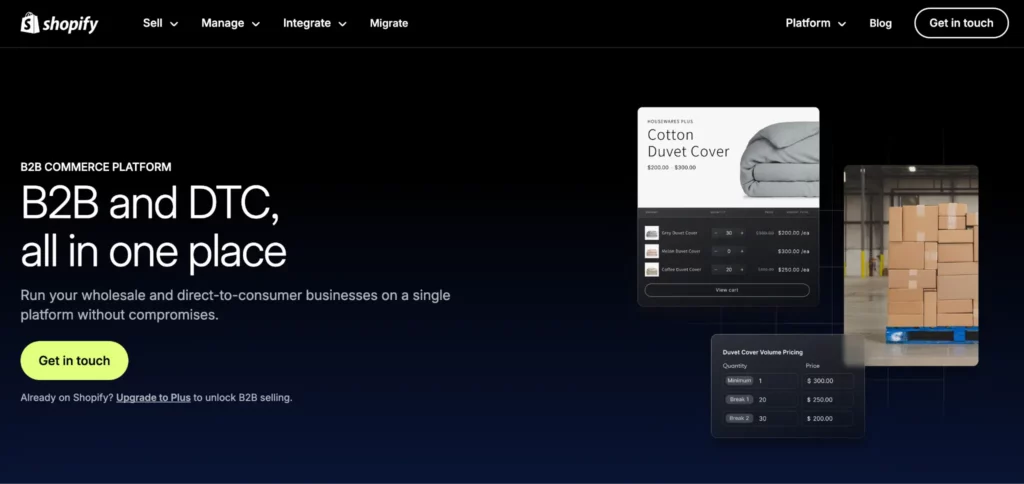
Image credit: Shopify Plus
Shopify Plus has come a long way from its B2C roots. Today, it offers a dedicated B2B suite with features like password-protected storefronts, volume-based pricing, purchase orders, and customer-specific catalogues.
It’s fast to set up, easy to manage, and works well for businesses looking to automate common tasks like reordering, invoicing, and customer segmentation.
For brands scaling quickly or running both B2C and B2B channels side by side, it’s a strong option. It’s not the most customisable platform on the market, but it’s hard to beat on simplicity, speed, and reliability.
Adobe Commerce
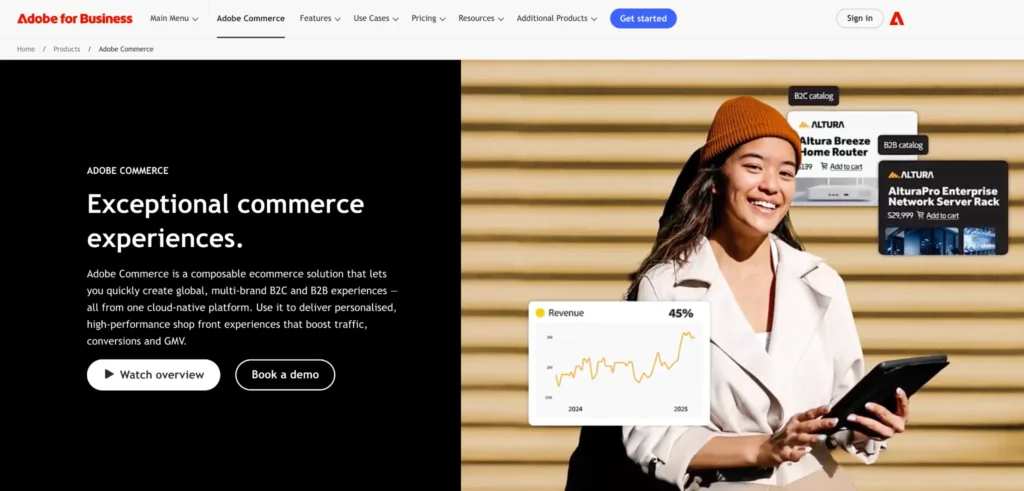
Image credit: Adobe Commerce
If your business needs total flexibility, Adobe Commerce is still one of the most powerful platforms available. It’s built to support complex operations, from multi-store setups and tiered account structures to custom quoting and advanced approval workflows.
It does require more technical support and a longer implementation window, so it’s best suited to companies with access to a development team or a trusted eCommerce agency. However, for businesses with international clients, large catalogues, and layered pricing models, it delivers unmatched control.
BigCommerce Enterprise
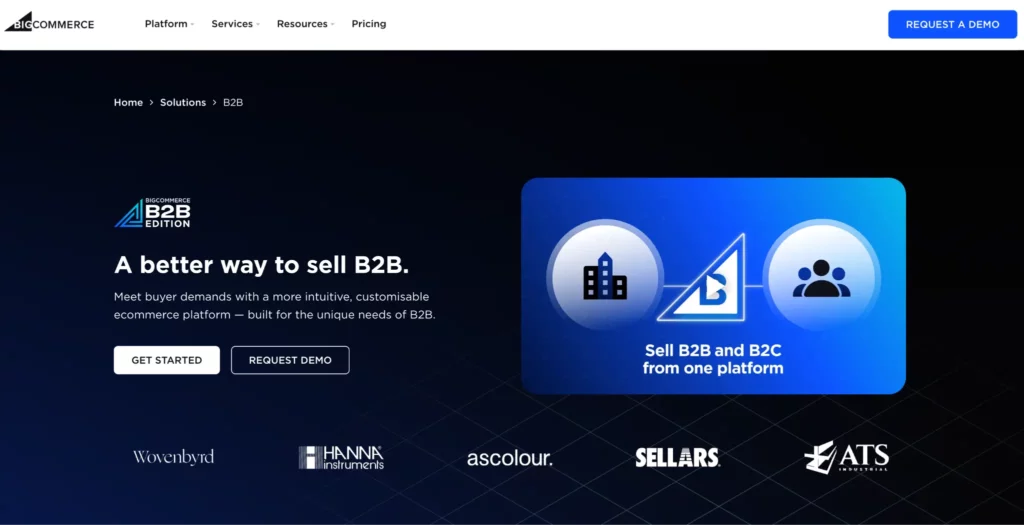
Image credit: BigCommerce
BigCommerce sits comfortably in the middle. It’s more flexible than Shopify but more manageable than Adobe. You get built-in B2B features like customer groups, shared shopping lists, and quote management without needing to bolt on too many extras.
It’s a good choice for brands that need enterprise-level features but don’t want the overhead of a full dev team. It also plays nicely with headless builds and has strong integration support, making it easier to plug into your existing tech stack.
OroCommerce
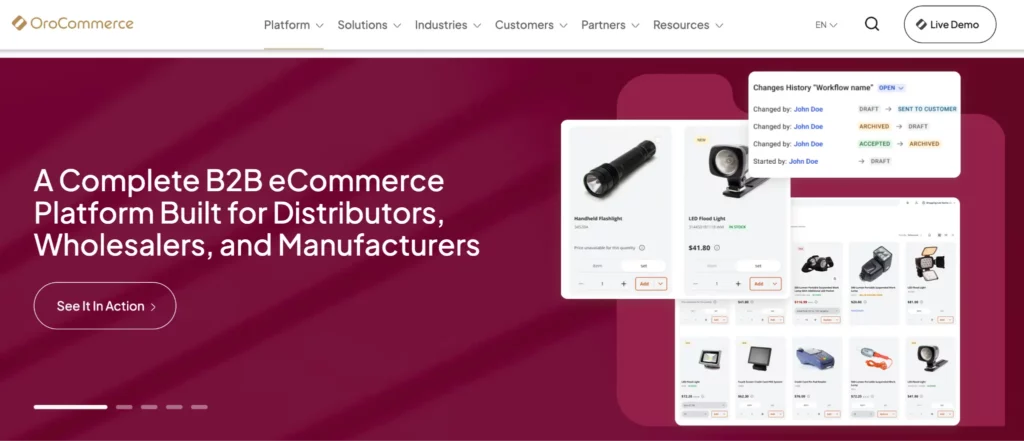
Image credit: OroCommerce
Unlike many platforms that adapt consumer tech to fit business needs, OroCommerce was purpose-built for B2B. Everything about it is designed around how businesses actually buy, so w’ere talking long decision cycles, negotiated pricing, customer-specific workflows, and multiple buyers per account.
If your business deals with complicated purchasing journeys or operates across multiple sales models, OroCommerce gives you the structure to manage it all. It does lean more technical, but for larger distributors and manufacturers, the functionality is spot on.
WooCommerce + B2B Plugins
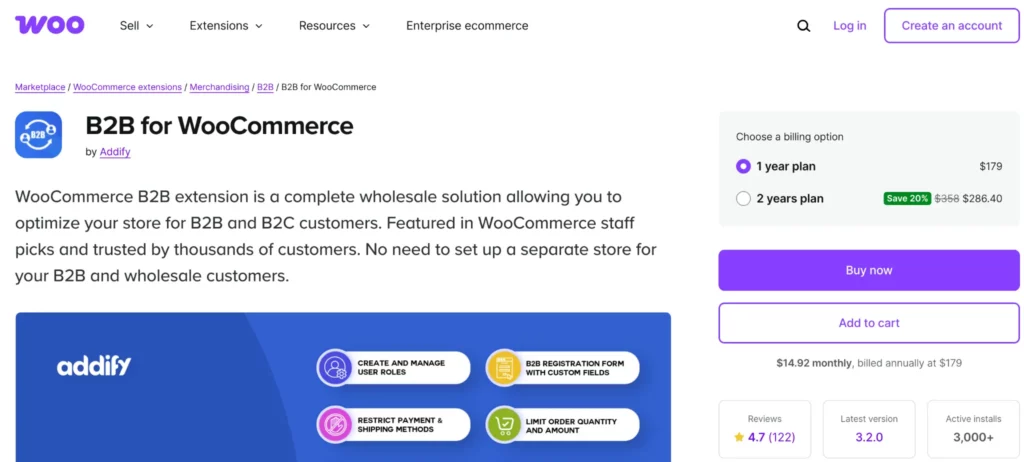
Image credit: WooCommerce + Addify B2B Plugin
For businesses that want control without paying enterprise-level licence fees, WooCommerce is a flexible, open-source option. While it doesn’t come with B2B tools out of the box, there’s a strong ecosystem of plugins that add features like dynamic pricing, product visibility by role, and custom payment terms.
It’s ideal if you already work with WordPress and want to keep your overhead low, but be prepared to manage your own hosting, updates, and security. If you have a lean in-house team or a trusted developer, it can be a powerful and cost-effective route.
Let’s take a look at how they all stack up side by side:
| Feature | Shopify Plus | Adboe Commerce | BigCommerce Enterprise | OroCommerce | WooCommerce + Plugins |
| Ease of use | Very user-friendly, intuitive for teams | Complex, dev-heavy | Moderately easy, modern UI | Developer-oriented, flexible | Familiar WordPress feel, setup varies |
| B2B features | Wholesale channel, custom pricing, net terms | Built-in quoting, company accounts, requisitions | Tiered pricing, quoting workflows | Built for B2B: quotes, workflows, segmentation | Extensions for quotes, roles, dynamic pricing |
| Pricing | From £1,550/month, plus % of GMV above ~£625k | From £17,000/year; cloud version £31K–£156K/year | From £390–£1,950/month, based on usage | Custom enterprise pricing (usually £20K+) | Core is free; hosting + plugins £400–£4,000/year |
| Integrations & APIs | 8,000+ apps, strong ERP/CRM API access | Full-stack ERP, CRM, PIM, headless-ready | Headless and ERP-ready; strong marketplace | Deep ERP/CRM support, flexible API framework | Plugin-based, self-managed API integrations |
| Scalability | Ideal for high-GMV brands and D2C+B2B hybrids | Excellent for complex global/multi-store needs | Handles mid to large volume well | Designed for enterprise B2B growth | Scales with tech support; DIY hosting required |
| Best for | Fast-growing brands needing automation + UX | Large businesses with dev teams and complex needs | Mid-market businesses balancing cost and power | Manufacturers, distributors, multi-role buyers | Brands wanting full control, low core costs, and customisation freedom |
So Which One Fits Your Business?
Running a fast‑growing wholesale business and want something turnkey?
- Shopify Plus is often the fastest path.
Handling enterprise workflows, quoting, large catalogs, international operations?
- Adobe Commerce offers the deepest toolkit.
Need a feature-rich but simpler system without massive overhead?
- BigCommerce Enterprise is a great balance.
Want B2B workflows without compromise and plenty of developer control?
- OroCommerce is a strong contender.
Prefer owning your hosting and full control, with lower ongoing licensing costs?
- WooCommerce + B2B extensions gives ultimate flexibility.
B2B eCommerce Marketing Strategies for 2025
The B2B buyer has changed. They’re digitally confident, they don’t want to waste time, and they’ll likely do most of their research long before anyone from your sales team gets involved.
That doesn’t mean marketing has to be over-engineered, but it does need to be wiser, sharper, and better aligned with how real people buy today.
So, let’s take a look at the B2B eCommerce best practices in more detail below.
1. Build a Content Ecosystem, Not Just a Blog
Most B2B brands have blogs. Few have content strategies. In 2025, buyers expect more than surface-level articles; they want tools, data, and answers tailored to their role, industry, and stage in the buying journey.
The most effective brands are investing in full-scale content ecosystems that include:
- Interactive product comparison tools
- ROI calculators and cost breakdowns
- Industry-specific landing pages and playbooks
- Detailed product use cases by sector
- Downloadable spec sheets and compliance docs
- Customer stories with measurable results
- Short, search-optimised video explainers
When this content is easy to find and clearly solves a problem, the value speaks for itself.
2. Treat Personalisation as a Revenue Driver
This isn’t just about greeting people by name. Personalisation in B2B eCommerce now extends across pricing, content, catalogue visibility, and even account management tools.
For businesses selling to multiple industries or buyer roles, one-size-fits-all experiences are a fast way to lose interest. Instead, platforms should tailor the journey, from landing to checkout, based on behaviour, account history, and company profile.
Personalised experiences convert better because they remove friction. If the buyer sees only what’s relevant to them, they move faster.
And while much of this happens through smart segmentation, more B2B brands are now using AI to go a step further, from automating product suggestions to adapting content based on live user behaviour.
You should definitely explore how AI can help grow your B2B eCommerce store in more detail, as this is something businesses should be leveraging.
3. Make SEO Less Robotic and More Intent-Led
In 2025, SEO is about showing up when your buyers are actively searching for help, not just optimising for product names. That means thinking the way your customers think.
If your content only targets “steel tubing supplier” or “enterprise CRM,” you’re missing intent. High-performing B2B pages now centre around actual buyer questions like:
“How to reduce supply chain delays in manufacturing”
“CRM platforms with multi-user access controls”
“Best industrial components with 48-hour delivery”
The more your content answers these, the more you show up when it matters.
Bonus: Voice search, YouTube, and marketplaces now carry serious SEO weight, so don’t ignore them!
4. Let Buyers Try Before They Commit
B2B buyers aren’t just comparing specs. They’re comparing how confident they feel about each option. Giving them a way to explore or test your product before they speak to sales is a game-changer.
Not every business can offer a live demo or sample, but you can still build in moments of interaction.
For physical products, this could be a sample request form or custom quote generator.
For services or software, it might be a calculator, configurator, or sandbox experience.
The goal is to give buyers enough clarity to take the next step. You’re removing hesitation, not replacing human contact.
5. Automate Your Follow-Ups Without Sounding Like a Robot
You know those emails that clearly came from a workflow? The ones that start “Just checking in on your interest…” and end up in the bin?
You don’t want to be that brand.
Smart automation in 2025 is less about the tools you use and more about how and when you reach out. The best follow-ups feel timely, relevant, and human, even if they’re fully automated behind the scenes.
Here’s how to avoid sounding robotic:
- Use behaviour-based triggers, not fixed timelines
- Reference what the buyer actually viewed or downloaded
- Offer something useful, not just a “nudge”
- Keep the tone light, not pushy
- End with a clear option: “Would a quick quote help?”
- Test plain-text style emails vs polished designs – plain often wins
- Don’t overdo it. Two strong messages beat five average ones
When it’s done right, buyers don’t care if it’s automated, they just feel like you’re paying attention.
6. Make Paid Media Feel Like Part of the Journey
If your paid ads still focus on “Buy Now” or “Schedule a Call,” it’s time to rethink. The most effective B2B campaigns in 2025 don’t rush the sale, they offer value up front, and only escalate when buyers show intent.
Picture this flow:
A prospect sees a benchmarking report in your LinkedIn ad → downloads it → gets retargeted with a short video case study → clicks through to your product page → is offered a demo or quote builder → books a call.
At no point were they pushed, just guided.
Think of paid media as a trail of helpful prompts, not a hard sell. The more aligned it is with your organic content and site experience, the more natural it feels. That’s when it works.
Real‑World Examples of B2B eCommerce
These brands are proving what smart business to business e commerce looks like in 2025. They balance efficiency, personalisation, and scale in different ways. They all offer insights worth learning from.
Amazon Business
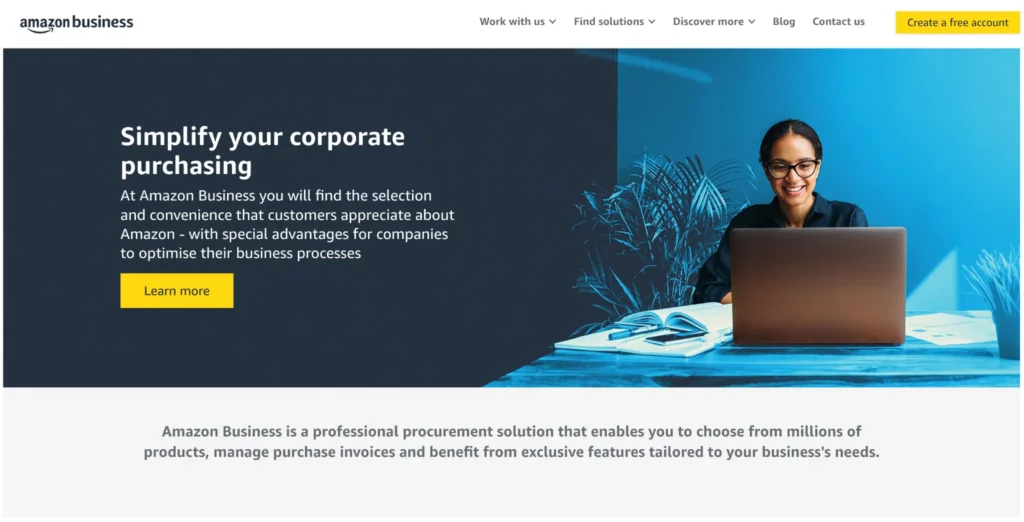
Image credit: Amazon Business
Amazon Business continues to lead by combining familiar UX with serious back-end functionality for enterprise buyers. The platform feels exactly like the consumer version; you get quick search, personalised recommendations, and frictionless checkout. However, under the hood, it supports everything from multi-user accounts and approval workflows to VAT invoicing and purchase order integration.
What makes it work is its ability to serve both small businesses and large procurement teams without overcomplicating the experience. Reordering is seamless, stock visibility is reliable, and the personalisation engine surfaces relevant products automatically. It’s fast, intuitive, and deeply embedded in how businesses already buy.
Curbell Plastics
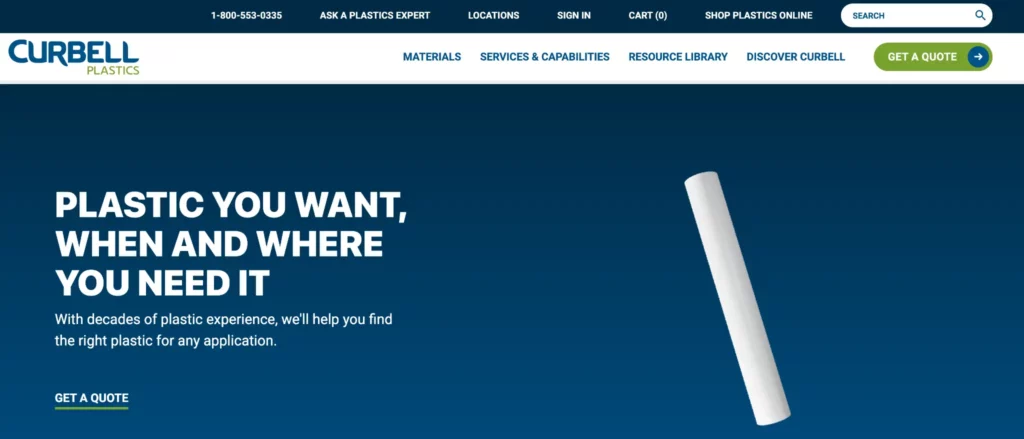
Image credit: Curbell Plastics
Curbell Plastics offers a quote-first eCommerce model tailored for industrial buyers. Rather than pushing buyers straight to checkout, the site encourages them to specify what they need, then matches them with pricing and delivery details through a fast-response quoting process.
Product navigation is highly detailed, with filters for size, material, tolerance, and industry use case. Technical documentation is easily accessible, and the UX is clearly designed for professionals who know exactly what they’re looking for. It’s efficient, accurate, and shows how niche suppliers can still deliver a world-class digital experience.
Alibaba
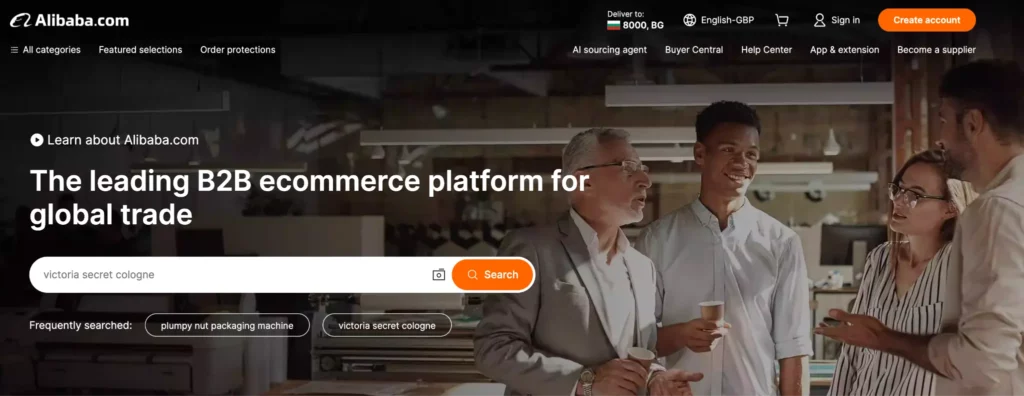
Image credit: Alibaba
Alibaba remains one of the most scalable and accessible B2B marketplaces globally. Its design prioritises product discovery, supplier verification, and logistics clarity, which are essential for buyers sourcing at scale across borders.
The experience is built around transparency. Buyers can see minimum order quantities, lead times, shipping options, and supplier ratings at a glance. There’s also a heavy focus on negotiation, custom quoting, and secure messaging, all within the platform. It proves that even complex, cross-border B2B transactions can feel smooth when trust and visibility are baked in.
Now It’s About Action
Buyers are expecting more, competitors are getting smarter, and platforms are evolving to meet new demands in speed, flexibility, and personalisation.
If you’re leading a B2B business in 2025, digital isn’t just a channel, it’s a strategy. The brands that are winning right now are the ones making it easier to buy, faster to reorder, and more relevant at every stage of the journey.
It’s about building an experience that reflects how your buyers actually want to work with you.
At Appnova, we help ambitious B2B brands design and build eCommerce experiences that perform and scale. Whether you’re starting fresh or levelling up what you already have, we’ll help you turn complexity into clarity and browsers into buyers.
Want to make your B2B eCommerce store your strongest sales channel? Let’s talk.
FAQs
What is a B2B eCommerce platform?
It’s a digital platform that allows one business to sell goods or services to another, typically with features like volume pricing, purchase order workflows, and multi-user access. Unlike consumer platforms, B2B tools are built to handle complex transactions and account-specific rules.
How to choose a B2B eCommerce platform?
Start by mapping your customer journey. Do your buyers need custom pricing? Frequent reorders? Account hierarchies? Look for platforms that support these needs out of the box, integrate with your existing systems, and are scalable enough to grow with you. Consider ease of use, B2B-specific features, and support.
How to grow a B2B eCommerce business?
Success comes from removing friction and building trust. Focus on making ordering faster, improving personalisation, and investing in content that educates buyers. Add automation where it saves time and use data to understand your most valuable segments. Seamless UX and smart marketing can make a measurable difference.
How to start B2B eCommerce?
Start small, but with a clear goal. Define your buyers, choose a platform that fits your structure, and build around your most common workflows. Launch with your core products, test the end-to-end journey, and refine based on real buyer behaviour. Don’t wait for perfection, iterate quickly and learn fast.
Subscribe To Us
Our Services
Categories
Subscribe To Us
Contributors
Categories

This website uses cookies so that we can provide you with the best user experience possible. Cookie information is stored in your browser and performs functions such as recognising you when you return to our website and helping our team to understand which sections of the website you find most interesting and useful. Third party cookies such as Google Analytics is also used on this site to provide analytics in order to better understand the user engagement on our site.
You can adjust all of your cookie settings by navigating the tabs on the left hand side.
Strictly Necessary Cookie should be enabled at all times so that we can save your preferences for cookie settings.
If you disable this cookie, we will not be able to save your preferences. This means that every time you visit this website you will need to enable or disable cookies again.







0.Comments